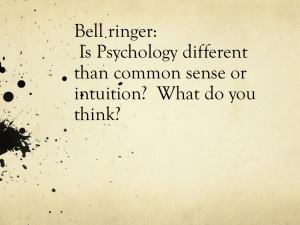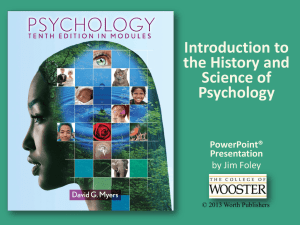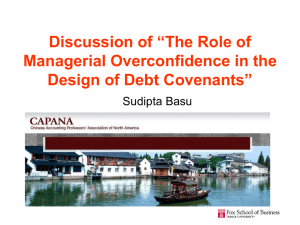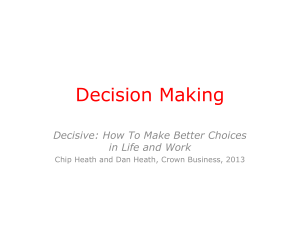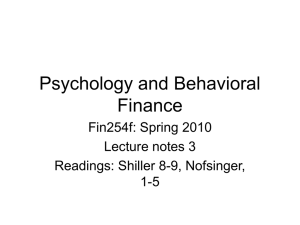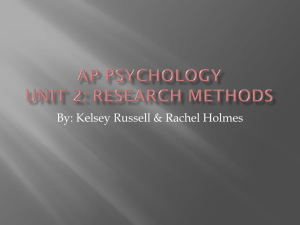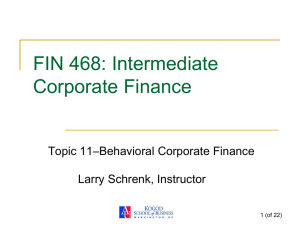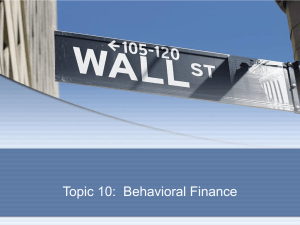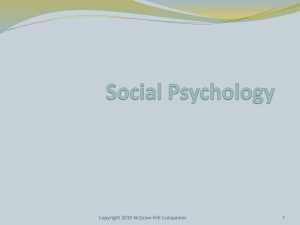Positive Affect and Overconfidence
advertisement
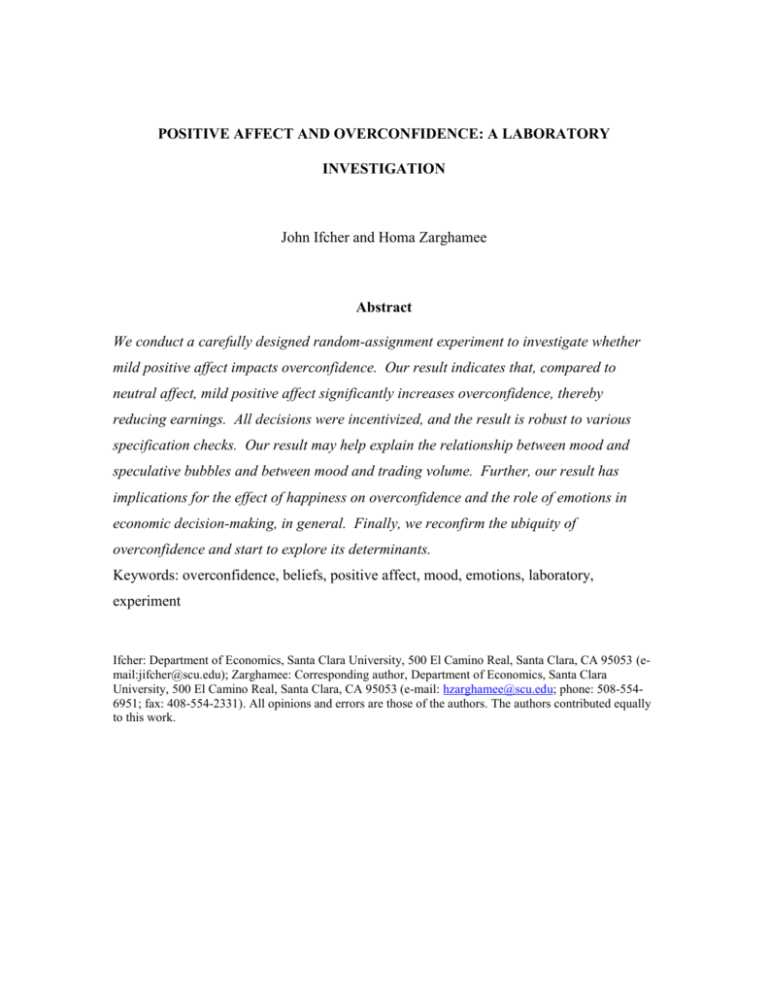
POSITIVE AFFECT AND OVERCONFIDENCE: A LABORATORY INVESTIGATION John Ifcher and Homa Zarghamee Abstract We conduct a carefully designed random-assignment experiment to investigate whether mild positive affect impacts overconfidence. Our result indicates that, compared to neutral affect, mild positive affect significantly increases overconfidence, thereby reducing earnings. All decisions were incentivized, and the result is robust to various specification checks. Our result may help explain the relationship between mood and speculative bubbles and between mood and trading volume. Further, our result has implications for the effect of happiness on overconfidence and the role of emotions in economic decision-making, in general. Finally, we reconfirm the ubiquity of overconfidence and start to explore its determinants. Keywords: overconfidence, beliefs, positive affect, mood, emotions, laboratory, experiment Ifcher: Department of Economics, Santa Clara University, 500 El Camino Real, Santa Clara, CA 95053 (email:jifcher@scu.edu); Zarghamee: Corresponding author, Department of Economics, Santa Clara University, 500 El Camino Real, Santa Clara, CA 95053 (e-mail: hzarghamee@scu.edu; phone: 508-5546951; fax: 408-554-2331). All opinions and errors are those of the authors. The authors contributed equally to this work. Introduction Beliefs are an important facet of standard utility theory. A systematic deviation from standard economic theory about beliefs is overconfidence, defined as the “overestimat[ion] of [one’s own] performance in tasks requiring ability, including the precision of [one’s own] information” (DellaVigna 2009). Overconfidence has been shown to be prevalent among the general public as well as investors, managers, and other important economic actors often considered too experienced to be subject to behavioral deviations from rational choice (Barber and Odean 2001). The overconfidence of various economic agents—CEOs, investors, and employees—has been critical in explaining the following phenomena: company underperformance, attractiveness of stock options to employees, overtrading, and gender differences in competitiveness (Barber and Odean 2001; Croson and Gneezy 2009; Malmendier and Tate 2005; and Oyer and Schaefer 2005). Given the far-reaching and significant implications of overconfidence, identifying its determinants and whether it is subject to manipulation is important. A noteworthy determinant of economic behavior that has been identified in economic and psychological experiments is the decision maker’s affect (or mood). Positive affect (or good mood) has been shown to significantly decrease risk aversion over low stakes (Isen and Geva 1987), perceived risk (Johnson and Tversky 1983; Lerner and Keltner 2001), time preference (Ifcher and Zarghamee 2011; and Pyone and Isen 2010), spending, and willingness to pay (Cryder et al. 2008; and Lerner et al. 2004); and to increase risk aversion over high stakes (Isen and Geva 1987), generosity (Kirchsteiger et al. 2006), work effort, productivity (Erez and Isen 2005; and Oswald et al. 2011), and loss aversion (Isen et al. 1988). 2 Further—and more suggestive of a relationship between positive affect and overconfidence—positive affect has been shown to improve self-efficacy (Lyubomirsky et al. 2005), task performance, and cognitive flexibility (Isen 2008) and to impact financial corollaries of overconfidence (Saunders 1993; Hirshleifer and Shumway 2003; and Edmans et al. 2006). These suggestive findings do not all point to the same qualitative relationship: some suggest that positive affect will increase overconfidence and others that it will decrease it. Further, past attempts at directly quantifying the effect of positive affect on overconfidence have suffered design flaws (Allwood and Bjorhag 1991; Kramer et al. 1993; Allwood et al. 2002; and Kuvaas and Kaufmann 2004), so further research is necessary. We conduct a laboratory experiment to identify the effect of positive affect on overconfidence. After completing a monetarily incentivized set of trivia and math questions, the control (treatment) group watches a neutral (positive) affect-inducing film clip. Subjects then estimate their performance, both in absolute terms and relative to other subjects. These estimations are also monetarily incentivized. We find that positive affect increases overconfidence, thereby reducing earnings. To our knowledge, ours is the first paper to investigate the effect of positive affect on self-efficacy, controlling for performance. Literature Review Overconfidence Experimental and field evidence of overconfidence abounds. In a range of contexts, decision makers’ own-estimated performance exceeds their actual performance, and their 3 estimated ranking among peers exceeds their actual ranking.1 That people are not good at estimating their performance on trivial topics—topics that are likely novel to them or outside the realm of their expertise—is quite natural. More interesting, though, is that we often tend to be biased toward over- and not under-estimation. Even more interesting is that this tendency does not disappear with experience. Overconfidence has been identified among clinical psychologists, physicians, nurses, investment bankers, engineers, entrepreneurs, lawyers, negotiators, and managers (Barber and Odean 2001). Further, Barberis and Thaler (2003) claim expertise actually exacerbates overconfidence. Indeed, many of the conditions faced by experts—e.g., abstractly defined goals, and decisions that are low in frequency or produce noisy feedback—are exactly ones that have been linked to biased and overconfident decision-making (Malmendier and Tate 2005). Given the broad range of actors subject to overconfidence, it is perhaps no surprise that it has been linked to important economic and financial phenomena. Overconfidence is often appealed to in behavioral finance models (Barberis and Thaler (2003) for a review of overconfidence in behavioral finance). There is also empirical evidence of overconfidence’s effect on economic decisions. Malmendier and Tate (2005) show that overconfident CEOs make inferior corporate investments; they are, among other things, overly sensitive to investment cash flows and prone to overpay for 1 Confidence-interval elicitation has also been used to measure overconfidence. Subjects are asked questions, but instead of simply estimating performance, they give 90% confidence intervals for each question. That these intervals are roughly 2 times tighter than they should be has been used as evidence of overconfidence (Alpert and Raiffa 1982). Recently, this method has been called into question. It has been shown that a good deal of measured overconfidence is simply a result of an aversion against broad-interval responses (Cesarini et al. 2006). Elicitation procedures that do not depend on confidence intervals result in lower estimates of overconfidence; importantly, they do not eliminate overconfidence. 4 mergers.2 Oyer and Schaefer (2005) provide empirical evidence of employees’ overconfidence to explain firms’ use of stock options for compensation.3 Of particular relevance to the current paper is research that links overconfidence to economic phenomena—asset-price bubbles and overtrading—on which the effect of positive affect has already been established. A large theoretical literature explains asset price volatility using overconfidence (Daniel et al. 1998). Scheinkman and Xiong (2003) model investors as being overconfident in the accuracy of their own information to help explain the creation of speculative bubbles. Further, an alternative explanation of speculative bubbles, the feedback theory (in which the success of investors who profit from speculative price hikes attracts public attention and boosts expectations of further price increases), may itself be a result of overconfidence (Shiller 2003). Michailova (2010) provides experimental evidence of overconfidence’s role in speculative bubbles. A psychological test of overconfidence is used to classify subjects as overconfident or “rational.” Markets comprising overconfident subjects are more likely to form bubbles, and their bubbles are significantly larger, than markets with rational subjects. A rich theoretical and empirical literature also exists that explains trading volume using overconfidence. To quote De Bondt and Thaler (1995), “the key behavioral factor needed to understand the trading puzzle is overconfidence. Overconfidence explains why 2 This finding is robust to different measures of overconfidence. First, overconfident CEOs are identified as those who hold on to private options longer than is rational. Second, overconfident CEOs are identified using the occurrence in the press of words suggestive of the CEOs’ overconfidence. 3 Using data from roughly 2000 firms, the authors perform calibrations of three competing models that seek to explain firms’ use of stock options. The first model is incentive-based, with employees increasing their productivity so that the firm’s profits, and hence their stock options, will be enhanced. The second asserts that firms use stock options to attract employees who are overconfident relative to the market about the firms’ performance and hence require lower total compensation. The third model contends that stock options, by increasing the employee’s cost of leaving a firm, improve the firm’s ability to retain employees. The authors patently reject the incentives-based model; show that any one theory is insufficient to explain the data; and conclude that a combination of the overconfidence- and retention-based models explains the data. 5 portfolio managers trade so much....” Barber and Odean (2001) exploit the gendered nature of overconfidence, particularly in financial markets where men exhibit more overconfidence than women, to indirectly test whether overconfidence impacts trading volume. Using data from 35,000 households over six years, they find that men trade significantly more than women and that trading reduces net returns more for men than women. Statman et al. (2006) and Kim and Nofsinger (2007) provide empirical evidence that the feedback theory noted above leads to overtrading and argue that overconfidence generates the feedback effect. Glaser and Weber (2007) provide direct empirical evidence. They track four years of trades by individual investors whose overconfidence has been measured with an online psychological questionnaire and find that overconfidence significantly increases trading volume. There are a number of known precursors of heightened overconfidence. As noted above, aspects of the decision-environment are known to lead to greater overconfidence. Men have been shown to exhibit more overconfidence than women (Lundeberg et al. 1994; Barber and Odean 2001; and Niederle and Vesterlund 2007). An aim of the current research is to determine whether positive affect is a determinant of overconfidence. Positive Affect and Overconfidence Over time, the themes around which the literature on the effects of positive affect has been organized have evolved. Recently, there is some convergence upon a “happier-andsmarter” theory, namely that positive affect improves information-processing and cognitive flexibility (Isen 2008). As explicitly hypothesized by Kuvaas and Kaufmann (2004), this suggests that positive affect should favor correct assessments and reduce 6 overconfidence. Indeed, support for this hypothesis is afforded by numerous studies that show positive affect increases task performance and problem solving (Lyubomirsky et al. 2005; and Isen 2008). At the same time, the positive-affect literature also indicate that it increases selfefficacy (Brown and Mankowski 1993; Lyubomirsky et al. 2005; and Schuettler and Kiviniemi 2006), which is defined as “people's beliefs about their capabilities to produce designated levels of performance that exercise influence over events that affect their lives (Bandura 1994).” Self-efficacy is closely linked to overconfidence, in that overconfidence can be thought of as undue perceived self-efficacy.4 While the link between positive affect and self-efficacy appears to suggest that overconfidence would be increased by positive affect, upon closer inspection, the valence of the relationship is unclear. For one, increased self-efficacy may be a justified response to improved performance or expected performance, leaving positive affect’s effect on overconfidence ambiguous: if the effect of positive affect on self-efficacy is less than proportional to its effect on performance, positive affect could give rise to underconfidence. More fundamentally, overconfidence is clearly defined by a schism between actual and estimated performance, whereas self-efficacy is not compulsorily linked to actual performance. 4 Positive affect is also correlated with heightened self-esteem. The discussion above focuses on selfefficacy because self-esteem is loosely if at all related to overconfidence. It is defined as “the extent to which one prizes, values, approves, or likes oneself (Blascovich and Tomaka 1991).” One may have low (high) self-esteem but know that she is an amazing (terrible) soccer player. Similarly, confidence and selfefficacy differ: “the construct of self-efficacy differs from the colloquial term "confidence." Confidence is a nonspecific term that refers to strength of belief but does not necessarily specify what the certainty is about. I can be supremely confident that I will fail at an endeavor. Perceived self-efficacy refers to belief in one's agentive capabilities, that one can produce given levels of attainment. A self-efficacy belief, therefore, includes both an affirmation of a capability level and the strength of that belief. Confidence is a catchword rather than a construct embedded in a theoretical system (Bandura 1997)." 7 So while there is substantial support for the effect of positive affect on selfefficacy, randomly assigned mood inducement has been used in, to our knowledge, only four psychological experiments to study the effect of affect on the difference between actual and self-assessed performance. Due to various shortcomings, none of these satisfactorily identify the effect of positive affect on overconfidence. Mood-inducement in Allwood and Bjorhag (1991) is unsuccessful except in the bad-mood treatment, so the effect of positive affect could not be studied (negative affect has no effect on overconfidence). Allwood et al. (2002) and Kuvaas and Kaufmann (2004) compare the effect of positive to negative without a neutral condition. This research can only answer whether good mood has more or less of an effect on overconfidence than bad mood; both studies find no difference between the overconfidence of subjects undergoing good- and bad-mood inducement.5 This is consistent with two very different interpretations: that positive affect and negative affect have no effect on overconfidence or that they have the same effect. Finally, the context of Kramer et al. (1993) is negotiations, and the researchers are concerned with interacted effects of induced mood and naturally occurring self-esteem. They find that positive affect improves performance but does not impact either expected rank or optimism about own-performance. Further, subjects in the positive-affect treatment are more likely to think they will achieve their own aspirations and, after negotiations, they are more likely to believe that they performed well relative to their negotiation partners. This is the closest the extant literature comes to identifying the 5 The effect of negative affect on behavior is complex and depends on the particular negative affect in question (e.g.. fear versus anger) and is not necessarily the opposite of positive affect (Isen 2007). This is further addressed in the discussion. We are investigating the effects of negative affect—fear, anger, and sadness—on overconfidence in other research. 8 effect of positive affect on overconfidence. The effect is only observed on postnegotiation comparisons with others and not on any self-evaluations, either pre- or postnegotiation, controlling for own-performance. Further, the validity of ascribing the results to randomly assigned mood-inducement is questionable. In this paper, mood-inducement is followed by a mood questionnaire, an overview of the negotiation task, a prenegotiation questionnaire, the negotiations, and a post-negotiation questionnaire. Because of the short-lived nature of experimentally induced mood (Isen and Gorgoglione 1983), it is likely that positive-affect had worn off by the post-negotiation questionnaire. The results attributed to positive affect may well be the consequence of improved performance alone. Lastly, we turn to the well-documented effects of positive affect on trading volume and bubbles, both corollaries of overconfidence identified in the behavioral finance literature, as noted above. The role of social mood in the formation of bubbles is put forth in Shiller (1984); Redhead (2008) studies the relationship in the 1990s dot-com bubble. Saunders (1993) and Hirshleifer and Shumway (2003) show that positive affect arising from unexpected sunshine increases trading volume; Edmans et al. (2006) shows the same using important and unexpected sports wins. Lahav and Meer (2010) provide an experimental test of the effect of positive affect on asset-market bubbles. Experimental asset markets experience significantly larger bubbles if subjects receive a positive moodinducement than if they do not. Combined with these and the Michaelova (2010) findings, our research can help identify a potential chain from positive affect to overconfidence to bubbles and overtrading, although it should be stated that our experiment is not specifically designed to identify such a chain. 9 Experimental Design In brief, our experimental procedure was as follows (additional details are provided below): First, subjects read detailed instructions regarding the experimental session; the instructions were also read aloud by the experimenter. Second, subjects read and signed the informed consent form. Third, subjects took a 30-question quiz. Fourth, the moodinducement procedure was administered. Fifth, subjects evaluated their performance on the quiz. Sixth, subjects answered questions regarding their mood. Seventh, subjects answered questions regarding their demographic and psychological characteristics. Finally, subjects received their certificates of payment and exited the experimental session. In total, the experimental session lasted approximately 45 minutes, and subjects received an average of $20 for their participation (all instructions and forms are presented in Appendix A). Subjects The laboratory experiment was conducted at Santa Clara University. One-hundred and seven undergraduate students were recruited from courses that all Santa Clara undergraduate students are required to take. These courses were chosen in an attempt to ensure that the sample was representative of the entire undergraduate student body. Prospective subjects were told that participation in the study would take less than an hour and that they would be paid for their participation, with an average payment of $20 and a minimum payment of $5 (the show-up fee). 10 Quiz (Activity 1) In the first part of the experiment, called Activity 1, subjects were given 15 minutes to complete a 30-question quiz. The instructions for Activity 1, which were also read aloud, stated that subjects would be paid $0.50 for each answer that was exactly correct, and that no partial credit would be given. The quiz included 20 trivia and 10 math questions. The trivia questions ranged in difficulty from, “The United States shares the longest unguarded border in the world with what country?” (correct answer: “Canada”) to, “Who ruled Iraq before Saddam Hussein?” (correct answer: “Ahmed Hassan al-Bakr”). The trivia questions closely followed those used by Moore and Small (2007). The math questions asked subjects to add five two-digit numbers; the two-digit numbers were generated randomly. The math questions were similar to those used in Niederle and Vesterlund (2007). Mood inducement We attempted to manipulate subjects’ mood by showing them a short film clip. The use of film clips to induce moods is common in psychological and, increasingly, economic experiments (Gross and Levenson 1995; Kirchsteiger et al. 2006; Rottenberg et al. 2007; Ifcher and Zarghamee 2011; and Oswald et al. 2011). Further, the use of film clips has been shown to be one of the most effective means of inducing mild positive affect (Westerman et al. 1996). In our experiment, half of the subjects (56 of 107) were randomly assigned to the treatment group and watched a film clip intended to induce positive affect. The other half of the subjects (51 of 107) were assigned to the control group and watched a film clip 11 intended to induce neutral affect. Except for the variant film clip, the experimental procedure was identical for the treatment and control groups. Our choice of film clips followed Gross and Levenson (1995), in which over 200 film clips were evaluated for their efficacy in inducing each of seven different affects. The positive-affect film clip was a short montage of stand-up comedy bits from the 2002 “Robin Williams – Live on Broadway.” The neutral-affect film clip was also one commonly used by psychologists and featured tranquil images of landscapes and wildlife in Denali National Park, Alaska (for example, Rottenberg et al. 2007). The film clips were both roughly 8 minutes long. Performance self-evaluation (Activity 2) In activity 2 subjects evaluated their performance on the quiz (Activity 1) by answering the following four questions: 1. ”How many of the 30 questions in Activity 1 do you think you answered correctly?” 2. “How well do you think you did in Activity 1?” where possible responses ranged from 1, “Very poor,” to 7, “Very well” 3. “I think that I answered _______________ more / fewer (circle one) questions correctly than did the typical participant in this session.”6 4. “In terms of correct answers in Activity 1, how do you think you performed relative to all the other participants in this session?” where possible responses ranged from 1, “Well below average,” to 7, “Well above average” 6 Immediately preceding this question on the form was the following statement: “Activity 1 had 30 questions. Compared to the typical participant in this session, how many more or fewer questions do you think you answered correctly? (In other words, compare how many of the 30 questions in Activity 1 you think the typical participant answered correctly to your answer to question #1 above). 12 Two of the four questions, the first and third, were incentivized financially. The instructions to Activity 2, which were also read aloud, informed the subjects in detail about the payment scheme for Activity 2. Specifically, subjects were informed that they would receive $5 if their answer to question 1 was correct, and $3 ($1) if their answer was within 3 (6) of the correct answer. The payment scheme for question 3 was similar, except that subjects had to estimate their relative performance within 2 (4) questions correctly to receive the $3 ($1) payment, respectively (again Appendix A contains the instructions for the entire experiment). Affect check (questionnaire 1) Next subjects completed the Positive Affect Negative Affect Schedule (PANAS) to confirm that the mood-inducement procedure had the intended effect (Watson et al. 1988). Specifically, subjects were asked to rate how much of 7 positive and 9 negative affects they felt during the film clip, where possible responses ranged from 1 (“You do not feel even the slightest bit of the emotion”) to 10 (“You feel the most of the emotion you have ever felt in your life”). The seven positive affects are amusement, arousal, contentment, happiness, interest, relief, and surprise; the nine negative affects are anger, confusion, contempt, disgust, embarrassment, fear, pain, sadness, and tension. The PANAS was framed to capture emotions felt during the film clip to avoid any confounding mood-effects from completing the self-evaluation (Activity 2). Further, since the primary objective of this research is to examine the impact of mild positive affect on overconfidence, the self-evaluation (Activity 2) was administered before the 13 Affect Check. This order of events eliminated the possibility that the induced mood would be moderated, or nullified, by the Affect Check. Subjects were also asked whether seeing the film clip made them “Happier,” “Neither happier, nor sadder,” or “sadder;” and whether the film clip put them in “A better mood,” “Neither a better, nor a worse mood,” or “A worse mood.” This question was included in Questionnaire 2 (described below) as a secondary affect check. Demographic and personality traits (questionnaire 2) and completing the session Finally, subjects were asked about their demographic and psychological characteristics, including happiness and personality traits. The measure of happiness comes from the question, “Taken all together, how would you say things are these days—would you say that you are…,” where possible responses ranged from 1 (completely unhappy) to 7 (completely happy). This measure is similar to the ones used in the General Social Survey and the World Values Survey, each of which has been used extensively in the happiness-economics literature as a measure of long-term happiness. When all subjects had completed Questionnaire 2 they received certificates of payments and exited the experimental session. The certificates included detailed instructions regarding redeeming the certificate for cash. The certificates also included the experimenters contact information, and subjects were instructed to contact the experimenters if they encountered problems redeeming their certificate. Certificates could be redeemed for cash one hour after the end of the session, and during all subsequent business hours, at an administrative office on the campus. 14 Initial results: subjects’ demographic characteristics, affect, and overconfidence Demographic characteristics Roughly half of the subjects are female and subjects’ average age is 20 (see Table I). Almost all of the subjects consider themselves to be either Asian (22 percent), Hispanic (14 percent), or White (57 percent). The division of students across colleges roughly mimics the university’s population: Arts & Science (42 percent), Business (36 percent) and Engineering (22 percent). More than three-quarters of the subjects are freshman; this is not surprising since most students take the required courses from which we recruited in their first year. The most heavily represented religion is Christianity, accounting for three-quarters of the subjects; this it is not surprising given that Santa Clara is a Jesuit university. Less than half of the subjects (47 percent) reported attending religious services at least once a month. Forty percent reported family incomes between $100,000 and $200,000, with 30 percent reporting family incomes of either less than $100,000 or more than $200,000. Finally, 36 percent of subjects self-identified as liberal, 42 percent as moderate, and 20 percent as conservative. For most demographic characteristics, there are not statistically significant differences between subjects in the treatment and control groups. However, despite random assignment, there are significant differences in academic class, religious service attendance, and political identity. Specifically, compared to the control group, the treatment group has a smaller proportion of: (a) freshmen (p-value = 0.074), (b) subjects who attend religious services more than once a month but less than once a week (p = 0.014); and (c) moderates (p = 0.003); and a greater proportion of liberals (p = 0.030). This number of differences is somewhat more than would be expected by chance. While 15 there is no obvious reason to believe that these differences would confound the results-since it is unclear how academic class, religious service attendance, and political identity interact with overconfidence--it is nonetheless prudent to control for these demographic characteristics in the econometric analysis. Mood inducement is successful Total positive affect—the sum of the seven positive affect scores from the PANAS—is significantly higher for subjects in the treatment than it is for subjects in the control group (29.80 versus 23.46, p = 0.002). Further, subjects in the treatment group report significantly higher levels of amusement (6.09 versus 3.32, p = 0.000), happiness (5.50 versus 4.43, p = 0.017), and interest (5.89 versus 4.28, p = 0.000). There is not, however, a significant difference between subjects in the treatment and control groups for the four remaining positive affects: arousal, contentment, relief, and surprise. Given that the target affect for the film clip is amusement, this is not surprising (Gross and Levenson 1995). Additional evidence that the mood-inducement procedure has the intended effect can be seen in responses to the following two questions from Questionnaire 2: “Did seeing the video clip put you in:” “A better mood,” “Neither a better, nor a worse mood,” or “A worse mood;” and “Did seeing the video clip make you:” “Happier,” “Neither happier, nor sadder,” or “Sadder.” The proportion of subjects in the treatment group who state that the film clip put them in “A better mood” and made them “Happier” is significantly greater than it is in the control group (0.61 versus 0.27, p = 0.004; and 0.64 versus 0.35, p = 0.003, respectively). 16 Total negative affect—the sum of the nine negative affect scores from the PANAS—is not significantly different for subjects in the treatment and control groups (15.29 versus 14.80, p = 0.773). Interestingly, however, for three of the nine negative affects subjects in the treatment group report at least marginally significantly higher scores: anger (1.64 versus 1.24, p = 0.099), disgust (1.88 versus 1.23, p = 0.012), and embarrassment (1.48 versus 1.04, p = 0.027). We do not believe that these three differences threaten the validity of the mood-inducement procedure for the following reasons: First, the average scores for these three negative affects are small in magnitude, ranging from 1.04 to 1.88. These are quite close to one, the bottom of the response scale (recall that possible responses ranged from one to ten). Second, the average score for these three negative affects is substantially smaller than the average score for the three positive affects that are affected by the mood-inducement procedure (1.41 versus 4.92). Third, the total negative affect score for subjects in the treatment and control groups is statistically indistinguishable. Fourth, the source of the increase in anger, disgust, and embarrassment is clear: among the subjects in the treatment group, there is a strong positive relationship between the frequency of church attendance and increased disgust and embarrassment. Presumably, Robin Williams’ extensive use of foul language in the positive-affect film clip generated this relationship. Finally, when we control for anger, disgust, and embarrassment in the econometric analysis our results become stronger. Subjects exhibit overconfidence The two primary measures of overconfidence used in this research are derived from the responses to questions 1 and 3, the incentivized questions from Activity 2. In particular, 17 “Absolute Overconfidence” (AOC) is defined as the difference between the estimated (question 1 from Activity 2) and actual number of correct answers on the quiz. For example, if a subject estimated that she answered 20 (14) questions correctly but actually answered 17 correctly, then the subject’s AOC would be +3 (-3). ”Relative Overconfidence” (ROC) is defined as the difference between a subject’s estimated (question 3 from Activity 2) and actual number of correct answers on the quiz relative to all subjects in the same session. For example, if a subject estimated that she answered 4 more (4 fewer) questions correctly than the average subject in the same session—and she actually answered 2 more questions correctly than the average in the session—then the her ROC would be +2 (-6). Subjects exhibit both AOC and ROC. Across all subjects average AOC is 3 and ROC is 1 (see Columns (2) and (3) of Table II). Overconfidence is diffuse, 72 percent of subjects exhibit AOC and 63 percent exhibit ROC. Further, the magnitude of AOC is large. Subjects overestimate their own performance by 17 percent, estimating, on average, that they answer three more questions correctly than they actually do; subjects average 17 correct answers on the quiz, but the average estimate is 20. Finally, subjects appear to be overconfident regarding other subjects’ performance as well, as ROC is on average smaller than AOC. That is, if subjects correctly estimated other subjects’ performance, then ROC should equal AOC. Given the well-established finding that men exhibit greater overconfidence than women, it is of interest to examine AOC and ROC by gender. As measured by AOC, men exhibit significantly greater overconfidence than do women (4.04 versus 1.78, p = 0.004); and a significantly greater proportion of men exhibit overconfidence than do women 18 (0.81 versus 0.62, p = 0.032) (see Columns (5) and (8) of Table II). As measured by ROC, however, there is no evidence that men exhibit greater overconfidence than do women (1.07 versus 1.04, p = 0.957) (see Columns (6) and (9) of Table II).7 Finally, AOC and ROC are regressed separately on each demographic characteristic to determine if there is a statistically significant relationship between overconfidence and the demographic characteristic; robust standard errors are calculated by clustering subjects by session. In the regressions with AOC as the regressand, two variables (in addition to female) have statistically significant coefficients: age (positive and significant), and Arts & Science (negative and marginally significant) (see Table III). In the simple regressions with ROC as the regressand, five variables have statistically significant coefficients: age (positive and marginally significant), other race (positive and significant), Christian (positive and highly significant), and family income between $100,000 and $200,000 ( negative and significant), and family income above $200,000 (positive and significant). Importantly, there are no significant relationships between AOC or ROC and demographic characteristics for which there is a significant difference between members of the treatment and control groups: being a freshman, moderate, and liberal, and attending religious services more than once a month but less than once a week. Main result: mild positive affect increases overconfidence 7 It is also interesting to note that men answer a significantly greater number of quiz questions correctly (17.77 versus 15.84, p-value < 0.001) (see Columns (4) and (7) of Table 2). On the 20 trivia questions, men significantly outperform women (9.07 versus 6.74, p-value < 0.001). However, on the ten math questions, performance is not significantly different across gender, with women insignificantly outperforming men (9.10 versus 8.71, p = 0.124). 19 To study the effect of mild Positive Affect (PA) on overconfidence, we estimate a model of the following form: Overconfidence = TTreatment + X’X + Y’Y (1) where Overconfidence is measured by AOC or ROC; Treatment is a treatment dummy that equals one if the subject is in the treatment group (and watched the positive-affect film clip) and zero otherwise; X denotes the vector of demographic control variables (gender, age, race, college, class, religious identity, religious service attendance, family income, and political identity); and Y denotes the vector of additional control variables (anger, disgust, embarrassment, the proportion of female subjects in a session, the number of correct answers on the quiz, and the number correct squared). The additional control variables are included for the following reasons: anger, disgust and embarrassment since the positive-affect mood inducement unexpectedly increases reports of these three negative affects; the proportion of female subjects in a session since women are less overconfident than men and the proportion of women in a session, which ranged fairly uniformly from 0.21 to 0.71, may have influenced other subjects’ overconfidence, especially ROC; and performance on the quiz since overconfidence may vary with performance on the quiz. Finally, OLS is used to estimate equation (1). Robust standard errors are calculated by clustering observations by session. Absolute overconfidence (AOC) 20 Estimating equation (1) without control variables, the coefficient on the treatment dummy is positive but insignificant (b = 0.94, p = 0.284). The estimated treatment effect increases in size and is marginally significant after demographic controls are added (b = 1.26, p = 0.090). Adding controls for anger, disgust, and embarrassment (the three negative affects that are unexpectedly elevated by the positive-affect film clip), the estimated treatment effect doubles in size and is now highly statistically significant (b = 2.55, p = 0.001). These controls are necessary for interpretation of our experimental result. These negative affects were unintentionally induced in the positive-affect treatment. Not controlling for them confounds their effect with that of positive affect. Finally, the magnitude and significance of the coefficient of interest are only slightly reduced when the two remaining control variables—the proportion of female subjects in a session and the performance on the quiz (and performance squared)—are added (b = 2.04, p = .018). (See Columns (1) through (4) of Table IV). Gender and AOC To examine whether the treatment effect differs for men and women, the interaction term, Treatment*Female, is added to equation (1). The coefficient on Treatment is larger and statistically significant (b = 3.38, p = 0.015) and the coefficient on Treatment*Female is negative and insignificant (b = -2.63, p = 0.124) (see Column (5) of Table IV). This indicates that the effect of mild positive affect on AOC is larger for men than for women. To further explore the variant gender-effect, equation (1) is estimated with the sample restricted first to female subjects and then to male subjects. For female subjects, the estimated treatment effect is negative and insignificant (b = -0.80, p = 0.656); for male 21 subjects, the estimated treatment effect is positive and marginally statistically significant (b = 1.80, p = 0.099) (see Columns (6) and (7) of Table IV).8 Looking at the impact of gender itself on AOC, the coefficient on female, though consistently negative, is only even marginally statistically significant in one specification, Table IV, Column (4) (b = -2.49, p = 0.092). Also, the proportion of female subjects in a session does not much impact the AOC of the session participants. Only when the sample is restricted to female participants is its coefficient even marginally statistically significant (b = 9.38, p = 0.069) (see Column (6) of Table IV). Relative overconfidence (ROC) The effect of mild positive affect on ROC is similar to its effect on AOC, but less marked both in terms of magnitude and statistical significance. In the regression of ROC on the treatment dummy, the effect of positive affect is positive but insignficant (b = 1.04, p = 0.273); and the addition of demographic controls has little effect (b = 1.35, p = 0.154). Controlling for anger, disgust, and embarrassment makes the effect of positive affect on ROC marginally significant (b = 1.69, p = 0.097). Finally, with the inclusion of the proportion of female subjects in the session and performance on the quiz as controls, conventional levels of significance are achieved, with positive affect increasing ROC (b = 1.61, p = 0.044) (see Columns (1) through (4) of Table V). Gender and ROC 8 We explored the possibility that this could be a result of the mood-inducement varying by gender. For both men and women, total positive affect is significantly higher in the positive-affect treatment than in the control group. Further, the magnitude and level of significance of the difference were the same across gender. Total negative affect did not vary by gender or treatment. 22 There is little support for the effect of positive affect significantly varying by gender. The coefficient on the treatment-female interaction in Column (5) is statistically insignificant (b = -1.85, p = 0.346). Further, the treatment effect is statistically insignificant for both female subjects (b = 0.643, p = 0.699)and male subjects (b = 1.32, p = 0.293) (see Columns (6) and (7)). That said, the point estimate of the treatment-female interaction in Column (5) is negative, which is consistent with the way in which the effect of positive affect on AOC varied by gender. Also, the point estimate of the treatmenteffect coefficient is almost twice as large for men as it is for women, consistent with the above finding that the effect of positive affect on AOC was greater for men than women. Gender itself does not have a statistically significant effect on ROC; the coefficient on female is statistically insignificant in all ROC specifications, and its sign is inconsistent. However, the proportion of women in the experimental session has a large negative effect on ROC; only when the sample is restricted to only men or only women is the effect insignificant (i.e. Columns (6) and (7) of Table V). Since AOC is unaffected by the proportion of female subjects, this suggests that subjects believe women will perform better than men on the quiz, a belief that is not consistent with the actual results. Discussion To identify the effect of positive affect on overconfidence, we conducted a randomassignment experiment in which subjects evaluated their performance on a quiz after experiencing either a positive or neutral affective shock. In summary, we find that mild positive affect increases overconfidence. Compared to subjects who experience a neutralaffect shock, those who experience a positive-affect shock estimate having performed 23 better on the quiz both in absolute terms and relative to their peers. Specifically, the positive-affect shock increases AOC by between approximately 1 and 3.4 questions and ROC by 1 and 2.6 questions. These effects correspond to AOC-increases of between 40% and 137% (the average AOC for subjects in the neutral-affect inducement is roughly 2.5 questions) and ROC-increases of between 200% and 520% (the average ROC for subjects in the neutral-affect inducement is roughly 0.5). The consequences of these increases in overconfidence are sizable. While not statistically significant, AOCpayments were 6.5% lower and ROC-payments were 13.8% lower for subjects in the positive-affect treatment relative to control. Overconfidence is a problem of beliefs, and beliefs are a precursor to observable behavior. As noted in the introduction, overconfidence may explain the effect of positive affect on trading volume and the persistence of speculative bubbles. Further, the effect of positive affect on overconfidence also has implications for how we interpret other existing research on the effect of positive affect on human behavior. For example, positive affect may decrease time preference by making us more overconfident of our ability to be patient or stave off future self-control problems. This result adds an important dimension to the emerging picture of positive affect’s impact on human behavior. It has been posited that positive affect increases cognitive flexibility by broadening focus and attention, promoting openness to information, and enabling improved integration of information. This suggests that positive affect should decrease overconfidence. That positive affect increases overconfidence and hence exacerbates mistaken belief-formation and reduces earning suggests that improved cognitive flexibility is not always positive affect’s primary effect. 24 Lastly, as expounded in Ifcher and Zarghamee (2011), it is important to provide guidance on what can be extrapolated from research investigating the impact of mood on behavior. First, the behavioral effects of intense mood-states are not necessarily amplifications of the effects of mild ones, so intense positive affect will not necessarily dramatically increase overconfidence (Isen 2007). Second, positive affect and negative affect do not necessarily have opposing effects, so our result does not suggest that negative affect will decrease overconfidence (Isen 2007). Finally, since it has been claimed by psychologists that, “frequent positive affect is both necessary and sufficient to produce the state we call happiness, whereas intense positive experience is not (Diener et al. 1991),” our result suggests that happier individuals may exhibit more overconfidence. 25 References Allwood, Carl Martin, and Carl Gustav Bjorhag. 1991. “Mood and Realism of Confidence Judgements of One’s Own Answers to General Knowledge Questions.” Scandinavian Journal of Psychology, 32(4): 358-71. Allwood, Carl Martin, Par Anders Granhag, and Anna-Carin Jonsson. 2002. “Does Mood Influence the Realism of Confidence Judgments?” Scandinavian Journal of Psychology, 43: 253-60. Alpert, Marc, and Howard Raiffa. 1982. “A Progress Report on the Training of Probability Assessors.” In Judgment Under Uncertainty: Heuristics and Biases, ed. Daniel Kahneman, Paul Slovic, and Amos Tversky, 294–305. Cambridge and New York: Cambridge University Press. Bandura, Albert. 1994. “Self-efficacy.” In Encyclopedia of Human Behavior Vol. 4., ed . Vilayanur S. Ramachadran, 71-81. New York: Academic Press. Bandura, Albert. 1997. Self-efficacy: The Exercise of Control. New York: Worth Publishers. Barber, Brad M., and Terrance Odean. 2001. “Boys Will Be Boys: Gender, Overconfidence, and Common Stock Investment.” Quarterly Journal of Economics, 116(1): 261–92. 26 Barberis, Nicholas, and Richard Thaler. 2003. “A Survey of Behavioral Finance.” In Handbook of the Economics of Finance, ed. George M. Constantinides, Milton Harris, and René M. Stulz, 1053-121. Amsterdam: Elsevier. Blascovich, Jim, and Joseph Tomaka. 1991. “Measures of Self-Esteem.” In Measures of Personality and Social Psychological Attitudes, ed. John P. Robinson, Laurence S. Wrightsman, and Frank M. Andrews, 115-60. San Diego: Elsevier. Brown, Jonathon D., and Tracie A. Mankowski. 1993. “Self-Esteem, Mood, and SelfEvaluation: Changes in Mood and the Way You See You.” Journal of Personality and Social Psychology, 64(3): 421-30. Croson, Rachel, and Uri Gneezy. 2009. “Gender Differences in Preferences.” Journal of Economic Literature, 47(2): 448-74. Cryder, Cynthia E., Jennifer S. Lerner, James J. Gross, and Ronald E. Dahl. 2008. “Misery is not Miserly: Sad and Self-Focused Individuals Spend More.” Psychological Science, 19(6): 525-30. Daniel, Kent, David Hirshleifer, and Avanidhar Subrahmanyam. 1998. “Investor Psychology and Security Market Under- and Overreactions.” Journal of Finance, 53(6): 1839–85. 27 De Bondt, Werner F. M., and Richard H. Thaler. 1995. “Financial Decision-Making in Markets and Firms: A Behavioral Perspective.” In Handbooks in Operations Research & Management Science, vol 9, ed. R.A. Jarrow, V Maksimovic, and W.T. Ziemba, 383-41. Oxford: Elsevier. DellaVigna, Stefano. 2009. “Psychology and Economics: Evidence from the Field.” Journal of Economic Literature, 47(2): 315-72. Diener, Ed, Ed Sandvik, and William Pavot. 1991. “Happiness Is the Frequency, Not the Intensity, of Positive Versus Negative Affect.” In Subjective Well Being: An Interdisciplinary Perspective, ed. Fritz Strack, Michael Argyle, and Norbert Schwarz, 119-40. Oxford: Pergamon Press. Edmans, Alex, Diego Garcia, and Oyvind Norli. 2007. “Sports Sentiment and Stock Returns.” Journal of Finance, 62(4): 1967–98. Erez, Amir, and Alice M. Isen. 2005. “The Influence of Positive Affect on the Components of Expectancy Motivation.” Journal of Applied Psychology, 87(6): 1055-67. Glaser, Markus, and Martin Weber. 2007. “Overconfidence and Trading Volume.” The Geneva Risk and Insurance Review, 1: 1-36. 28 Hirshleifer, David, and Tyler Shumway. 2003. “Good Day Sunshine: Stock Returns and the Weather.” Journal of Finance, 58(3): 1009–32. Ifcher, John, and Homa Zarghamee. 2011. “Happiness and Time Preference: The Effect of Positive Affect in a Random-Assignment Experiment.” American Economic Review, 101(7): 3109-29. Isen, Alice M. 2007. “Positive Affect, Cognitive Flexibility, and Self-Control.” In Persons in Context: Building a Science of the Individual, ed. Yuichi Shoda, Daniel Cervone, and Geraldine Downey, 130-47. New York: The Guilford Press. Isen, Alice M. 2008. “Some Ways in Which Positive Affect Influences Decision Making and Problem Solving.” In Handbook of Emotions, ed. Michael Lewis, Jeannette M. Haviland-Jones, and Lisa Feldman Barrett, 548-73. New York: The Guilford Press. Isen, Alice M., and Nehemia Geva. 1987. “The Influence of Positive Affect on Acceptable Level of Risk: The Person with a Large Canoe has a Large Worry.” Organizational Behavior and Human Decision Processes, 39(2): 145-54. Isen, Alice M., and Joyce M. Gorgoglione, 1983. “Some Specific Effects of Four AffectInduction Procedures.” Personality and Social Psychology Bulletin, 9(1): 136-43. 29 Isen, Alice M., Thomas E. Nygren, and Gregory F. Ashby. 1988. “Influence of Positive Affect on the Subjective Utility of Gains and Losses: It is just not Worth the Risk.” Journal of Personality and Social Psychology, 55(5): 710-17. Johnson, Eric J., and Amos Tversky. 1983. “Affect, Generalization, and the Perception of Risk.” Journal of Personality and Social Psychology, 45(1): 20-31. Kim, Kenneth A., and Nofsinger, John R. 2007. “The behavior of Japanese individual investors during bull and bear markets.” Journal of Behavioral Finance, 8: 138-53. Kramer, Roderick M., Elizabeth Newton, and Pamela L. Pommerenke. 1993. “SelfEnhancement Biases and Negotiator Judgment: Effects of Self-Esteem and Mood.” Organizational Behavior and Human Decision Processes, 56: 110-33. Kuvaas, Bard, and Geir Kaufmann. 2004. “Impact of Mood, Framing, and Need for Cognition on Decision Makers’ Recall and Confidence.” Journal of Behavioral Decision Making, 17: 59-74. Lahav, Yaron, and Shireen Meer. 2010. “The Effect of Induced Mood on Prices in Experimental Asset Markets.” Working Paper. Lerner, Jennifer S., and Dacher Keltner. 2001. “Fear, Anger, and Risk.” Journal of Personality and Social Psychology, 81(1): 146-59. 30 Lerner, Jennifer S., Deborah A. Small, and George Loewenstein. 2004. “Heart Strings and Purse Strings.” Psychological Bulletin, 15(5): 337-341. Lundeberg, Mary A., Paul W. Fox, and Judith Puchochar. 1994. “Highly Confident but Wrong: Gender Differences and Similarities in Confidence Judgments.” Journal of Educational Psychology, 86(1): 114-21. Lyubomirsky, Sonja, Laura King, and Ed Diener. 2005. “The Benefits of Frequent Positive Affect: Does Happiness Lead to Success?” Psychological Bulletin, 131(6): 80355. Malmendier, Ulrike, and Geoffrey Tate. 2005. “CEO Overconfidence and Corporate Investment.” Journal of Finance, 60(6): 2661–700. Michailova, Julija. 2010. “Overconfidence and bubbles in experimental asset markets.” MPRA Paper 26390, University Library of Munich, Germany. Moore, Don A., and Small, Deborah A. 2007. “Error and bias in comparative judgment: On being both better and worse than we think we are.” Journal of Personality and Social Psychology, 92, 972–89. 31 Niederle, Muriel, and Lise Vesterlund. 2007. “Do Women Shy Away from Competition? Do Men Compete Too Much?” Quarterly Journal of Economics, 122(3): 1067-101. Oswald, Andrew, Eugenio Proto, and Daniel Sgroi. 2011. “Happiness and Productivity.” Working paper. Oyer, Paul, and Scott Schaefer. 2005. “Why Do Some Firms Give Stock Options to All Employees?: An Empirical Examination of Alternative Theories.” Journal of Financial Economics, 76(1): 99–133. Pyone, Jin Seok, and Alice M. Isen. 2011. “Positive Affect, Intertemporal Choice, and Levels of Thinking: Increasing Consumers’ Willingness to Wait.” Journal of Marketing Research, 48(3). Redhead, Keith. 2008. “A Behavioural Model of the Dot.Com Bubble and Crash.” Economics, Finance, and Accounting Applied Research Working Paper Series, Coventry University Business School. Saunders, Edward M., Jr. 1993. “Stock Prices and Wall Street Weather.” American Economic Review, 83(5):1337–45. Scheinkman, Jose A., and Wei Xiong. 2003. “Overconfidence and speculative bubbles”, Journal of Political Economy, 111(6): 1183-219. 32 Shiller, Robert J. 1984. “Stock prices and social dynamics.” Brookings Papers on Economic Activity 2: 457−98. Shiller, Robert J. 2003. “From Efficient Market Theory to Behavioral Finance.” Journal of Economic Perspectives, 17(1): 83–104. Statman, Meir, Steven Thorley, and Keith Vorkink. 2006. “Investor Overconfidence and Trading Volume.” The Review of Financial Studies, 19(4): 1531-65. Watson, David, Lee Anna Clark, and Auke Tellegen. 1988. “Development and Validation of Brief Measures of Positive and Negative Affect: The PANAS Scales.” Journal of Personality and Social Psychology, 54(6): 1063-70. 33 Table I: Demographic characteristics of the subjects Control (neutral affect) Treatment (positive affect) 0.467 (0.05) 0.471 (0.07) 0.464 (0.07) 20.004 (0.21) 20.154 (0.14) 19.870 (0.37) Asian 0.215 (0.04) 0.235 (0.06) 0.196 (0.05) Black 0.065 (0.02) 0.078 (0.04) 0.054 (0.03) Hispanic 0.140 (0.03) 0.137 (0.05) 0.143 (0.05) White 0.570 (0.05) 0.529 (0.07) 0.607 (0.07) Other race 0.009 (0.01) 0.020 (0.02) 0.000 (0.00) Arts & Sciences 0.421 (0.05) 0.412 (0.07) 0.429 (0.07) Business 0.355 (0.05) 0.392 (0.07) 0.321 (0.06) Engineering 0.224 (0.04) 0.196 (0.06) 0.250 (0.06) Freshman 0.766 (0.04) 0.843 (0.05) * 0.696 (0.06) * Sophomore 0.150 (0.03) 0.098 (0.04) 0.196 (0.05) Junior 0.056 (0.02) 0.020 (0.02) 0.089 (0.04) Senior 0.028 (0.02) 0.039 (0.03) 0.018 (0.02) Atheist 0.112 (0.03) 0.157 (0.16) 0.071 (0.03) Christian 0.766 (0.04) 0.725 (0.06) 0.804 (0.05) Other religion 0.112 (0.03) 0.098 (0.04) 0.125 (0.04) ≤Once a year 0.159 (0.04) 0.196 (0.06) 0.125 (0.04) >Once a year & <Once a month 0.308 (0.31) 0.314 (0.07) 0.304 (0.06) Once a month 0.112 (0.03) 0.031 (0.30) 0.125 (0.04) >Once a month & <Once a week 0.196 (0.04) 0.098 (0.04) ** 0.286 (0.06) ** ≥Once a week 0.112 (0.03) 0.137 (0.05) 0.089 (0.04) < $100,000 0.299 (0.04) 0.275 (0.06) 0.321 (0.06) >$100,000 & <$200,000 0.402 (0.05) 0.412 (0.07) 0.393 (0.07) > $200,000 0.299 (0.04) 0.314 (0.07) 0.286 (0.06) Conservative 0.196 (0.04) 0.235 (0.06) 0.161 (0.05) Moderate 0.421 (0.05) 0.275 (0.06) *** 0.554 (0.07) *** All Female Age^ Race College Class Religious identity^ Religious service attendance^^^ Family Income^ Political identity^^ Liberal 0.364 (0.05) 0.471 (0.07) ** 0.268 (0.06) ** 107 51 56 Observations standard errors in parenthesis. ^, ^^, and ^^^ signify one, two, and 12 missing observations, respectively. *, **, and *** signify that the means are significantly different with a p-value < 0.10, 0.05, and 0.01, respectively. 34 Table II: Mean quiz performance, AOC, and ROC by gender All subjects Quiz performance (1) Mean Proportion 16.87 (0.29) - Minimum 10 Men Absolute Relative overconfidence overconfidence (2) (3) 2.98 (0.39) 2.98 (0.39) 0.72 -7 0.63 -7.4 (0.04) (0.05) Quiz performance (4) 17.77 (0.37) *** - Women Absolute Relative overconfidence overconfidence (5) (6) 4.04 (0.46) *** 1.07 (0.42) 0.81 0.68 -7.4 11 (0.05) ** -3 (0.06) Quiz performance (7) 15.84 (0.41) *** 10 24 12 6.8 24 10 6.8 20 Maximum 107 107 104 57 57 55 50 Observations^ standard errors in parenthesis. ^ three ROC observations are missing. *, **, and *** signify that the means are significantly different for men and women with a p-value < 0.10, 0.05, and 0.01, respectively. 35 Absolute Relative overconfidence overconfidence (8) (9) 1.78 (0.61) *** 1.04 (0.41) 0.62 -7 0.56 (0.07) -4.0 12 50 6.8 49 (0.07) ** Table III: Results from regressing each demographic characteristic on AOC and ROC Absolute overconfidence Female -2.255 (0.76) ** Age^ 0.317 (0.06) *** Relative overconfidence -0.032 (0.70) 0.160 (0.08) * Race Asian 0.411 (0.72) -0.396 (0.59) Black -1.050 (1.91) -0.612 (1.57) Hispanic -0.133 (1.04) -0.636 (0.49) 0.043 (0.87) 0.688 (0.69) 0.019 (0.45) 1.624 (0.48) ** White + Other race College Arts & Sciences -1.233 (0.61) * -0.452 (0.39) Business 0.682 (0.63) Engineering 0.830 (0.62) 0.747 (0.48) -0.314 (0.73) 0.289 (0.77) -0.266 (0.97) Sophomore -0.052 (1.12) 0.109 (1.06) Junior -0.686 (0.66) 0.568 (1.19) Senior -0.324 (2.32) 0.123 (2.03) -1.856 (1.15) -1.300 (0.87) Class Freshman Religious identity^ Atheist Christian 0.759 (0.74) 1.457 (0.36) *** Other religion 0.209 (1.21) -0.949 (0.56) -0.537 (1.34) 0.260 (0.97) >Once a year & <Once a month 0.378 (0.77) 0.234 (0.64) Once a month 0.209 (1.39) 0.556 (0.85) >Once a month & <Once a week 0.438 (1.43) -0.259 (0.61) ≥Once a week 0.490 (1.22) 0.261 (0.85) < $100,000 -0.285 (1.06) -0.181 (0.66) >$100,000 & <$200,000 -0.669 (0.89) -1.350 (0.42) ** 1.052 (0.63) 1.771 (0.57) ** -0.273 (1.10) 0.626 (0.60) 0.646 (0.84) 0.562 (0.40) -0.414 (0.96) -0.612 (0.55) Religious service attendance^^^ ≤Once a year Family Income^ > $200,000 Political identity^^ Conservative Moderate Liberal Observations standard errors in parenthesis. ^, ^^, and ^^^ signify one, two, and 12 missing observations, respectively. + there is only one subject in this category *, **, and *** signify that the means are significantly different with a p-value < 0.10, 0.05, and 0.01, respectively. 36 Table IV: Estimating equation (1) AOC 37 Table V: Estimating Equation (1) ROC 38
